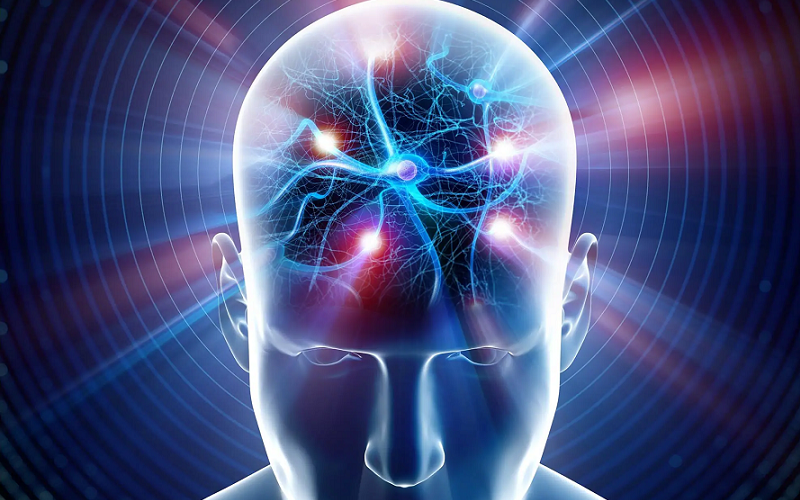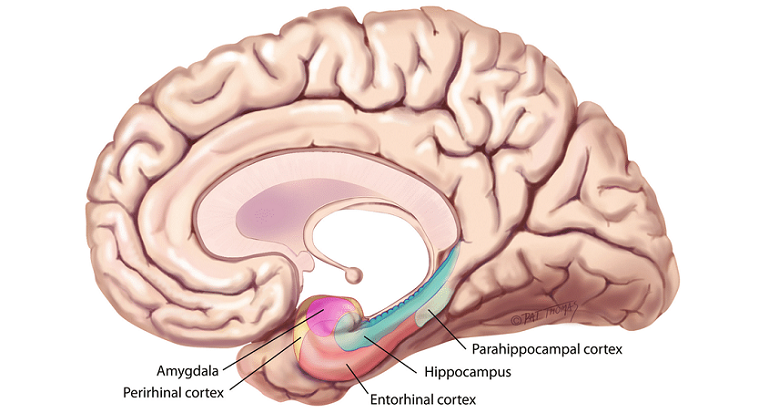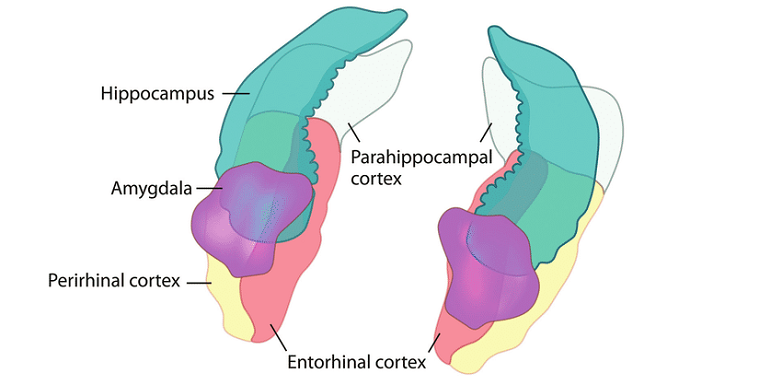
The entorhinal cortex, a lesser-known but vital component of the brain’s medial temporal lobe, plays a crucial role in our ability to form and recall memories as well as navigate our surroundings. Often referred to as the gateway to the hippocampus, this small region facilitates the seamless integration of information necessary for these cognitive functions.
Contents
Anatomy and Function of the Entorhinal Cortex
The entorhinal cortex is an essential component of the brain’s memory and spatial navigation systems. To better understand its significance, let’s first examine its location, connections, and the roles it plays in our cognitive functions.
Location Within the Medial Temporal Lobe
Situated in the medial temporal lobe of the brain, the entorhinal cortex lies adjacent to the hippocampus and the amygdala. The medial temporal lobe is known for its involvement in learning and memory, and the entorhinal cortex serves as a critical hub for information processing within this region.
Connection to the Hippocampus
The entorhinal cortex is often referred to as the gateway to the hippocampus due to its role in transmitting information between the hippocampus and the neocortex. The perforant pathway, a major neural pathway connecting the entorhinal cortex and the hippocampus, is crucial for the consolidation of long-term memories. The two-way communication between these regions allows the brain to integrate sensory inputs and generate appropriate responses.

Role in the Limbic System
As part of the limbic system, the entorhinal cortex contributes to emotional processing and the formation of memories. The limbic system includes several interconnected brain structures, such as the hippocampus, amygdala, and cingulate cortex, which work together to regulate emotions, learning, and memory.
Subregions and Their Functions
The entorhinal cortex can be divided into two primary subregions, each with distinct functions and cell types: the lateral entorhinal cortex (LEC) and the medial entorhinal cortex (MEC).
Lateral entorhinal cortex (LEC)
The LEC is involved in processing non-spatial information, such as objects and their features. It receives input from various sensory cortices and sends projections to the hippocampus. The LEC plays a vital role in the formation and retrieval of episodic memories, which encompass personal experiences and events in our lives [1].
Medial entorhinal cortex (MEC)
The MEC, on the other hand, focuses on spatial information processing. It contains specialized cell types, such as grid cells, border cells, and head direction cells, which together create an internal map of our environment. The MEC’s spatial representations are essential for navigation and the formation of spatial memories [2].

The Entorhinal Cortex and Memory
The entorhinal cortex plays a central role in memory processing, particularly in the formation and retrieval of episodic and semantic memories.
Types of Memory
Memory, a crucial aspect of human cognition, allows us to store, process, and retrieve information from our experiences. However, not all memories are created equal or serve the same purpose.
Episodic memory
Episodic memories refer to our recollection of personal experiences and events, complete with information about the time, place, and associated emotions. The entorhinal cortex, particularly the lateral entorhinal cortex (LEC), is crucial for processing these memories [3]. It integrates non-spatial information and relays it to the hippocampus, enabling the formation and retrieval of episodic memories.
Semantic memory
Semantic memory involves our knowledge of general facts, concepts, and meanings that are not tied to specific experiences. Although the entorhinal cortex’s role in semantic memory is less prominent than in episodic memory, it still contributes to the organization and consolidation of these memories through its connections with the hippocampus.
Role in Memory Consolidation
The entorhinal cortex serves as a bridge between the neocortex and the hippocampus, facilitating the flow of information necessary for memory consolidation [4]. During this process, the entorhinal cortex sends information to the hippocampus via the perforant pathway, helping to transform short-term memories into long-term ones. Additionally, the entorhinal cortex receives information from the hippocampus, which aids in the retrieval of existing long-term memories.
Long-term potentiation (LTP) is a synaptic plasticity mechanism that strengthens the connections between neurons, enabling the formation of long-lasting memories. The entorhinal cortex, in conjunction with the hippocampus, plays a vital role in LTP, ensuring that relevant neural connections are enhanced and maintained over time.
Importance in Alzheimer’s Disease
Alzheimer’s disease, a progressive neurodegenerative disorder, is characterized by memory loss and cognitive decline. Research has shown that the entorhinal cortex is one of the earliest brain regions to be affected by the disease [5]. The accumulation of amyloid-beta plaques and neurofibrillary tangles in the entorhinal cortex disrupts its function, impairing memory formation and retrieval.
The degeneration of the entorhinal cortex in Alzheimer’s disease directly affects memory processing. As the gateway to the hippocampus becomes compromised, the flow of information necessary for memory consolidation is disrupted. This leads to the hallmark memory loss observed in Alzheimer’s patients, particularly affecting episodic memories.

The entorhinal cortex, particularly the medial entorhinal cortex (MEC), is a vital player in our ability to navigate our environment. It contains specialized cell types that work together to create an internal map of our surroundings.
Grid Cells
Grid cells were first discovered in 2005 by the Norwegian neuroscientists Edvard and May-Britt Moser. These cells exhibit a unique firing pattern that forms a hexagonal grid when an animal navigates through an environment. This discovery earned the Mosers and their mentor, John O’Keefe, the 2014 Nobel Prize in Physiology or Medicine.
Grid cells provide a metric framework for spatial navigation, essentially encoding an internal coordinate system [6]. They fire at regular intervals as an animal moves through space, regardless of the environment’s specific features. This allows the brain to keep track of an animal’s position and calculate distances between different locations.
Border Cells
Border cells, another class of specialized neurons in the MEC, are responsible for encoding the boundaries of an environment. They fire selectively when an animal is near the edges of its environment, such as walls or barriers. Border cells contribute to the spatial representation of the environment by defining its limits and providing contextual information for navigation.
Border cells and grid cells work together to create a comprehensive map of an environment [7]. While grid cells provide a coordinate system to track an animal’s position, border cells offer information about the environment’s boundaries. The integration of these two types of spatial information allows for accurate navigation and the formation of spatial memories.
Head Direction Cells
Head direction cells are neurons that fire selectively when an animal’s head points in a specific direction. These cells are found in various regions of the brain, including the MEC, and play a crucial role in encoding the animal’s orientation within its environment.
The information provided by head direction cells is critical for other spatial navigation cells, such as grid cells and border cells, to function effectively [8]. By incorporating directional information, these cells can create a more accurate and complete representation of the environment, enhancing the brain’s ability to navigate complex spaces.
Future Entorhinal Cortex Research Directions
As our understanding of the entorhinal cortex and its role in memory and spatial navigation continues to grow, researchers are exploring new avenues to apply this knowledge in various domains. This section highlights potential applications in technology, therapeutic interventions for memory disorders, and methods to enhance memory and spatial navigation abilities.
Potential Applications in Technology
Insights gained from studying the entorhinal cortex and its specialized cell types can be used to develop more accurate and efficient navigation systems. By mimicking the brain’s internal coordinate system and integrating environmental context, these systems could improve positioning and route planning for autonomous vehicles, drones, and other technologies that rely on spatial information.
Understanding the neural mechanisms underlying memory and spatial navigation in the entorhinal cortex can also contribute to advancements in artificial intelligence and robotics. By implementing algorithms that mimic the brain’s spatial representations and memory processing, robots could navigate complex environments more effectively and adapt to new situations, making them more versatile and useful in various applications.
Therapeutic Interventions for Memory Disorders
Given the entorhinal cortex’s early degeneration in Alzheimer’s disease, it is a prime target for potential therapeutic interventions. Research focusing on preventing or reversing the damage to this region could lead to more effective treatments for Alzheimer’s patients, helping to slow or halt memory loss and cognitive decline.
Understanding the entorhinal cortex’s role in memory and spatial navigation may also inform the development of cognitive rehabilitation techniques for individuals suffering from memory impairments due to brain injury or other neurological disorders. By targeting the entorhinal cortex and its connections, these interventions could help restore lost memory functions or improve existing cognitive abilities.
Brain-computer interfaces (BCIs) have the potential to directly modulate neural activity in the entorhinal cortex, offering a means to enhance memory and spatial navigation abilities. By stimulating specific neural pathways, BCIs could improve the encoding, consolidation, and retrieval of memories, benefiting individuals with memory impairments or those seeking to enhance their cognitive performance.
Non-invasive neurostimulation methods, such as transcranial magnetic stimulation (TMS) and transcranial direct current stimulation (tDCS), could also be used to target the entorhinal cortex and its connections. These techniques may provide a safe and effective way to modulate neural activity, potentially improving memory and spatial navigation abilities in both healthy individuals and those with cognitive impairments.
References
[1] Memory for events and their spatial context: Models and experiments
[2] Disentangling the Role of the MEC and LEC in the Processing of Spatial and Non-Spatial Information
[3] Lateral Entorhinal Cortex Suppresses Drift in Cortical Memory Representations
[4] About Sleep’s Role in Memory
[5] The Blood-Brain Barrier: Understanding the Brain’s Natural Defense System
[6] Entorhinal grid-like codes and time-locked network dynamics track others navigating through space
[7] Functional network topography of the medial entorhinal cortex
[8] The Brain’s Navigational Place and Grid Cell System

